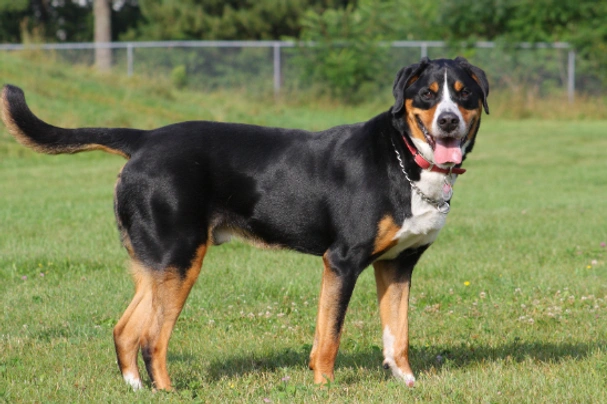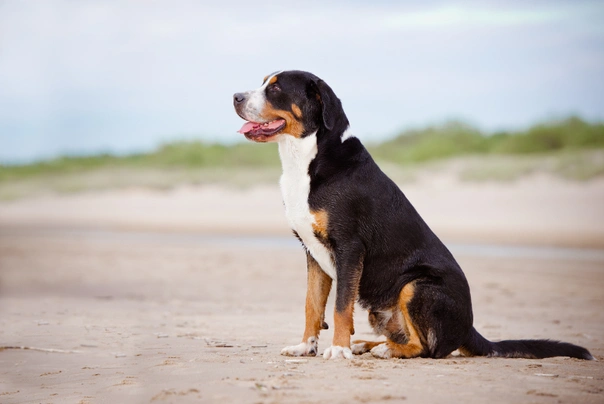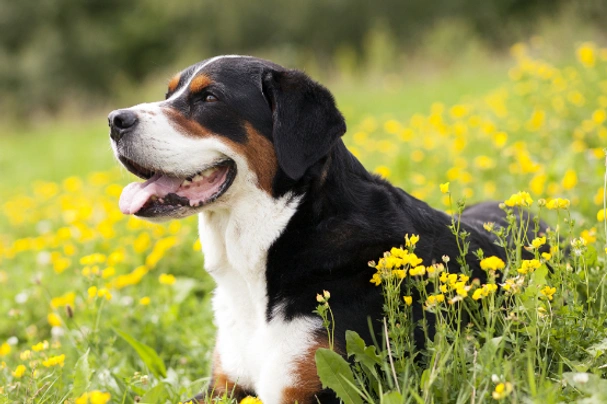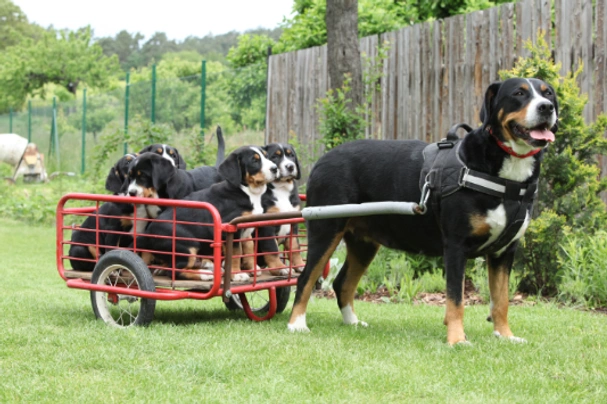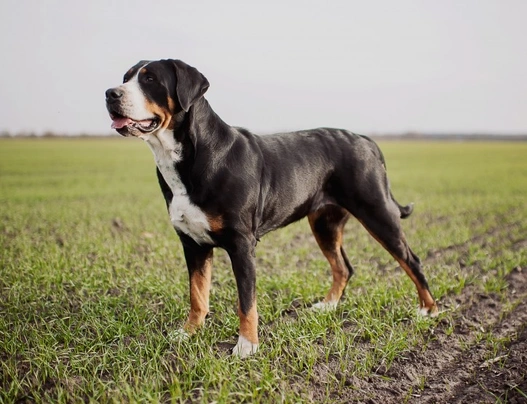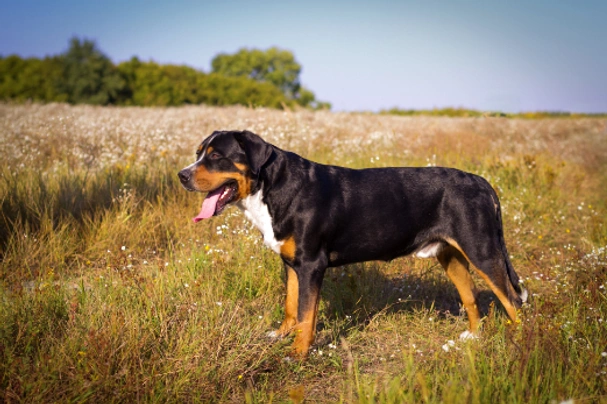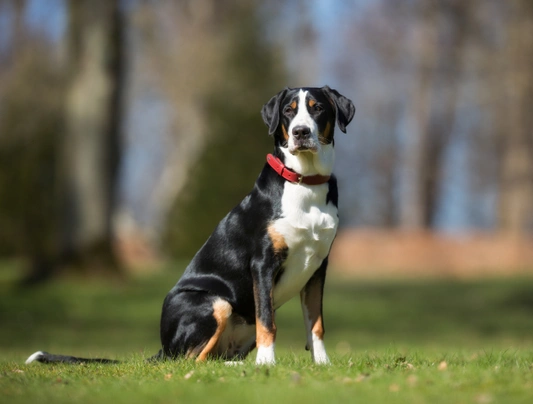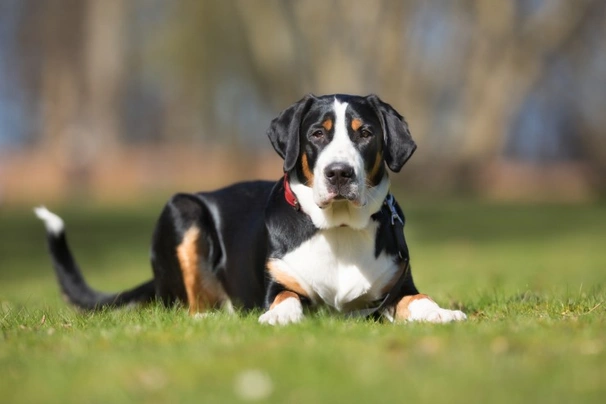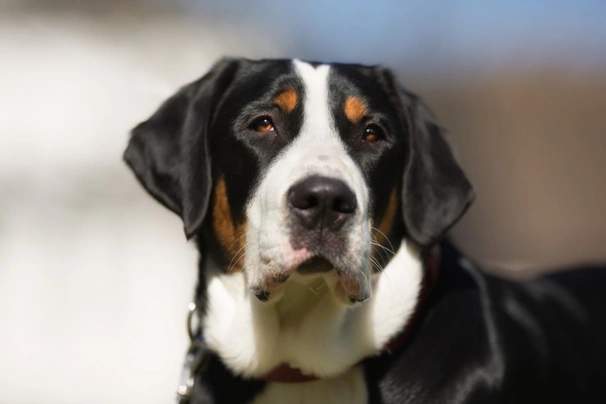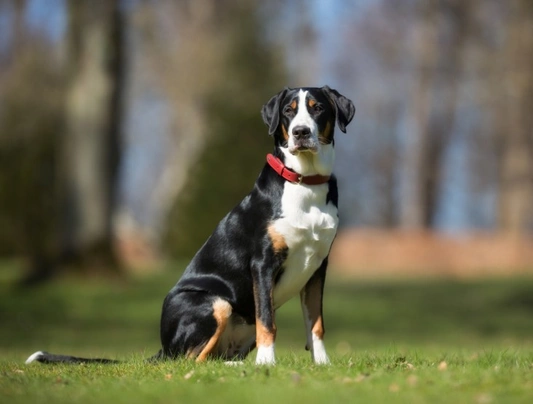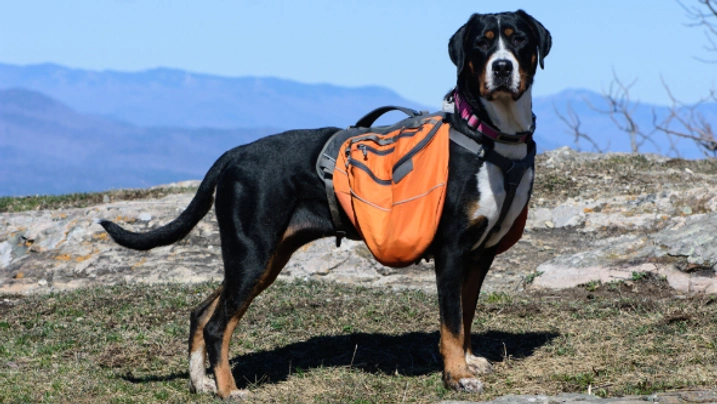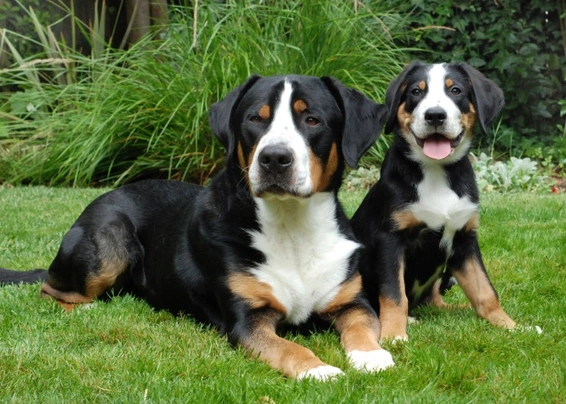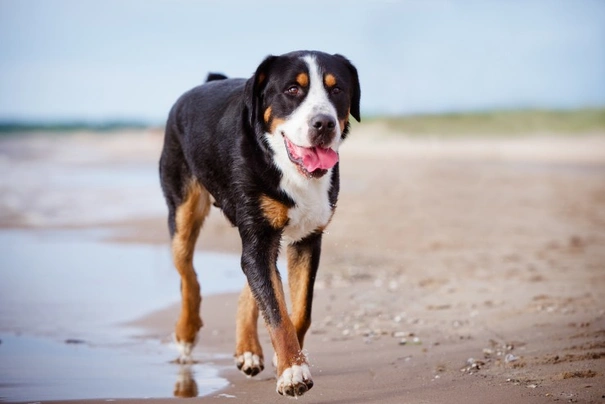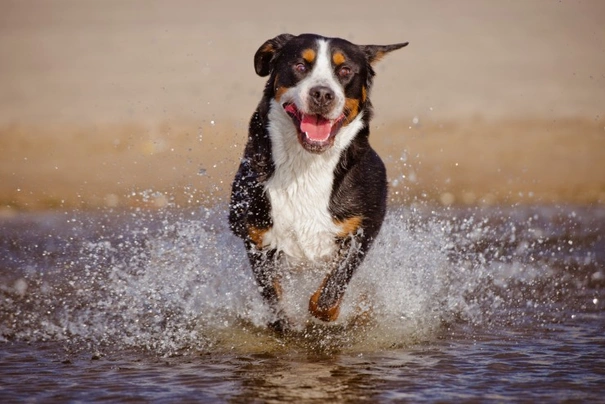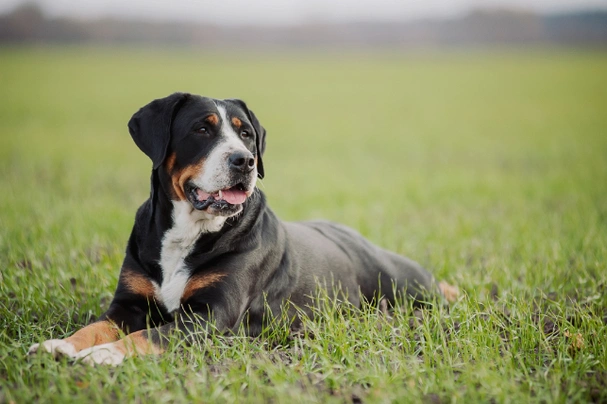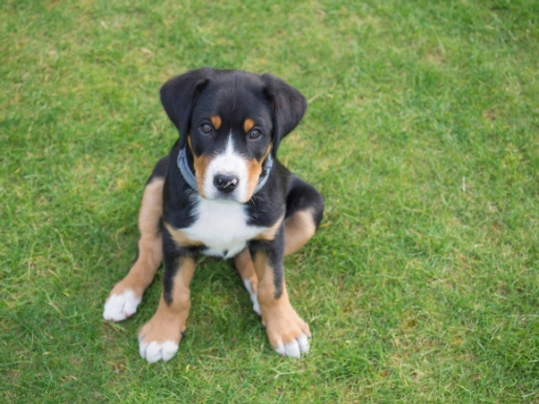Greater Swiss Mountain Dog
Pros
Cons
Introduction of the Greater Swiss Mountain Dog
The Greater Swiss Mountain Dog is a large dog and one that's not that dissimilar to the Bernese Mountain Dog having the same charming coat colour and markings. They are known to have calm and trustworthy dispositions which is paired to a willingness to please. Today the Greater Swiss Mountain Dog is still very highly prized in their native Switzerland for being a good family pet and with more breeders producing excellent examples of the breed here in the UK these handsome large dogs are starting to find their way into the hearts and homes of many people over here and elsewhere in the world too.
History of the Greater Swiss Mountain Dog
The Greater Swiss Mountain Dog is thought to be a descendant of dogs left in Switzerland by the Romans over 2000 years ago and it’s thought they have some Molosser in them. The dogs the Romans bought with them were crossed with local herding breeds and the result was a very distinct type. There are in fact four types which the Swiss classified by their coat colour and size with one of them being the Bernese Mountain Dog and another the Greater Swiss Mountain Dog with both dogs being very similar looking.
However other people believe these dogs are descendants of dogs the Phoenicians took with them when they travelled to Spain in 110 BC and that these dogs later found their way to the Swiss Alps. A third theory is that they are descendants of dogs found in Europe during the Neolithic Period of history.
Although highly prized for their herding and guarding abilities Swissies were also used to pull carts to market right up until the advent of cars. They were often bred to Saint Bernards which is thought was to improve the gene pool. When puppies were born with the looks of a Saint Bernard they were called “Saint Bernards” whereas if they resembled Swissies they were Swissies. As time passed however their numbers fell drastically low until a man called Franz Schertenlieb heard about the breed’s dilemma. He made it his mission to seek out Greater Swiss Mountain Dogs and found one dog which he exhibited in the Bernese Class in 1908.
This caught the attention of a Judge called Dr. Albert Heim who went about promoting the breed to farmers and other breed enthusiasts. Once enough Swissies were found Schertenlieb set up a breeding programme. During World War II Swissies were used as military dogs.
Over time the breed was developed in the remote valleys of the Swiss Alps where they were used to herd and guard livestock and to pull milk wagons which they often did in pairs but Greater Swiss Mountain Dogs were also kept as watchdogs and family pets on remote farms. The breed was first recognised in their native Switzerland in 1910 when they were referred to as the Grosse Schweizer Sennehund.
In the 20th century the breed's popularity grew throughout Europe although these handsome dogs are still considered quite a rare breed both in their native Switzerland and elsewhere in the world. A breed club was set up in American in 1968 and later in 1995 the Greater Swiss Mountain Dog was accepted into the American Kennel Club and the breed is Kennel Club registered in the Working Dog group in 2008.
Interesting facts about the breed
- Is the Greater Swiss Mountain Dog a vulnerable breed? No they are very popular in Europe but finding puppies in the UK can prove challenging and they tend to be expensive as a result
- Swissies are very well developed and could do the work of a horse with no trouble at all
- They were originally bred to herd and guard flocks in their native Switzerland
- Swissies really hate being tied up
- They love a home environment and are therefore not keen to take off and roam
- The breed was only recognised by the Kennel Club in 2008 but full recognition was only granted in 2016
- During World War II Swissies were used as military dogs.
- There were several Greater Swiss Mountain Dog winners at Crufts in 2018 namely BOB Rus Ch Sennehund Estate Cornelia and BOS INT CH Korona Rossii Nobel WW’12
Appearance of the Greater Swiss Mountain Dog
Height at the withers: Males 65 - 72 cm Females 60 - 68 cm
Average weight: Males 60 - 70 kg Females 50 - 60 kg
Greater Swiss Mountain Dogs have the same charming markings and coat colour as their Bernese Mountain Dog cousins with the one difference being their coats are shorter and therefore they require a lot less in the way of grooming. They have strong large heads with a flat broad skull. They have a slight furrow and stop with their muzzles being square and longer than they are deep. Their eyes are a nice almond shape medium in size and can be a lovely hazel to dark brown in colour with dogs always having a kind alert expression in them.
Their ears are set quite high medium in size and nicely covered in hair being triangular in shape and they lie flat when a dog is relaxed but they bring their ears forward when alert. The Greater Swiss Mountain Dog has a strong jaw with a perfect scissor bite where their upper teeth neatly overlap their lower ones. Their necks are moderately long very strong and muscular without any dewlap. Shoulders are strong long well-muscled and sloping with dogs having straight well boned front legs.
They have well developed broad chests and nicely developed forechests. Ribs are well laid back and slightly rounded and their backs are level and strong with dogs having well-muscled and broad loins. Their croup is broad gently sloping and long with dogs having nicely developed first and second thighs. Feet are well arched compact and round with very strong nails. Their tails are set level with the croup which dogs hang down when resting but raised when on the move or alert.
When it comes to their coat the Greater Swiss Mountain Dog has a dense double coat with their outer coat being moderately long and the undercoat being either grey or black in colour. The accepted coat colour for Kennel Club registration is as follows:
- Tricolour - the main colour being black with dogs having symmetrical tan markings together with white markings too
It is worth noting that the accepted breed colours for Kennel Club registration can differ from those set out in the breed standard which are as follows:
- Tri-colour with the main colour being black and dogs having symmetrical tan coloured markings together with clean white markings
Gait/movement
When a Greater Swiss Mountain Dog moves they have a good reach and lots of drive from behind always nicely balanced when at the walk or faster paces.
Faults
The Kennel Club frowns on any exaggerations or departures from the breed standard and would judge the faults on how much they affect a dog's overall health and wellbeing as well as their ability to perform.
Males should have both testicles fully descended into their scrotums and it is worth noting that a dog can be a little lighter or heavier as well as slightly taller or shorter than set out in the Kennel Club breed standard which is only given as a guideline.
Temperament of the Greater Swiss Mountain Dog
The Greater Swiss Mountain Dog is known to be a trustworthy loyal and calm character that becomes totally devoted to their families. They like nothing more than to be in a home environment and are always eager and willing to learn new things which in short means in the right hands these handsome large dogs are easy to train. They are highly intelligent and as such they need to be given lots of mental stimulation to keep them occupied and happy.
They are confident dogs by nature and because they are always so alert to what's going on around them they are always quick to let an owner know when there is anyone around or when something they don’t like is happening around them. With this said because they are so self-assured the Greater Swiss Mountain Dog readily accepts being around people they don't know providing their owners are about.
These handsome large dogs are a great choice for first time owners thanks to their trustworthy and kind natures however anyone wanting to share a home with a GSMD would need to have a large house and ideally a very big back garden where their dogs would be able romp around in whenever they can.
Are they a good choice for first time owners?
Greater Swiss Mountain Dogs are a good choice for first time dog owners providing they have the time to dedicate to such an intelligent large dog and one that needs a ton of mental stimulation and daily exercise to be truly happy well-rounded dogs.
What about prey drive?
Greater Swiss Mountain Dogs are very social by nature and generally get on with everyone and everything but they do like to chase small animals when they get the chance. As such care should always be taken as to where and when a Swissy can run off the lead more especially if there is livestock or wildlife close by.
What about playfulness?
Swissies have a very playful side to their natures and love to entertain and be entertained. They are known to be a little mischievous when the mood takes them and being so clever they quickly learn what pleases an owner and how to get their own way when they want something.
What about adaptability?
Great Swiss Mountain Dogs are large and need enough room to express themselves as they should. As such they are better suited to people who have large secure back gardens a dog can safely roam around in whenever possible.
What about separation anxiety?
Although Swissies form strong ties with their families they do not generally suffer from separation anxiety providing they are never left to their own devices for too long. No dog likes to be on their own for too long which could lead to them being destructive around the home which is a dog's way of relieving any stress they are feeling and a way to keep themselves entertained.
What about excessive barking?
Swissies are not known to be “barkers” and will generally only voice an opinion when they think it is necessary to do so which is why they make such wonderful watchdogs.
Do Great Swiss Mountain Dogs like water?
Most Swissies love swimming and will take to the water whenever they can more especially when the weather is hot. However if anyone who owns a dog that does not like water should never force them to go in because it would just end up scaring them. With this said care should always be taken when walking a GSMD off the lead anywhere near more dangerous watercourses just in case a dog decides to leap in and then needs rescuing.
Are Greater Swiss Mountain Dogs good watchdogs?
Swissies are excellent watchdogs because they are always vigilant and guarding their owners and properties is something that comes naturally to them. With this said rarely would Swissy do so aggressively preferring to stand their ground until an owner shows up.
Intelligence / Trainability of the Greater Swiss Mountain Dog
The Greater Swiss Mountain Dog is highly intelligent and they love to please which when added together means they are quick to learn new things. In the right hands and with the correct amount of socialisation from a young enough age these charming dogs learn things quickly and they thoroughly enjoy the one-to-one attention they are given during a training session. The downside is that a GSMD learns the bad things just as quickly which is why their training and handling must be consistent.
Puppies need to be well socialised from a young age and this should include introducing them to as many new situations noises people other animals and dogs once they have been fully vaccinated. This goes a long way in helping dogs mature into well-rounded and well-behaved characters no matter what situation they find themselves in.
Like all puppies a Greater Swiss Mountain Dog puppy is incredibly cute and it is all too easy to spoil them when they first arrive in a new home. However an adorable puppy quickly grows up to be a large mature dog. As such once a puppy is nicely settled in they must be taught the rules and boundaries so they understand what is expected of them. It also helps establish a pecking order and who is alpha dog in a household. The first commands a puppy should be taught are as follows:
- Come
- Sit
- Stay
- Heel
- Quiet
- Leave it
- Down
- Bed
Children and other
The Greater Swiss Mountain Dog thrives in a family environment and are known to be very good and gentle with children of all ages. However because they are such large dogs care must be taken when they are around toddlers just in case they knock a child over albeit by mistake which could end up frightening or hurting a child.
If well socialised from a young age the Greater Swiss Mountain Dog usually gets on well with other dogs. Rarely would one of them show any sort of aggressive behaviour towards another dog. If they grow up with a family cat in the home they generally get on well together but they might chase off a neighbour's cat if the opportunity ever arises. However care must be taken when they are round any smaller animals and pets just in case.
Health of the Greater Swiss Mountain Dog
The average life expectancy of a Greater Swiss Mountain Dog is between 8 and 11 years when properly cared for and fed an appropriate good quality diet to suit their ages.
Like so many other breeds the Greater Swiss Mountain Dog is known to suffer from a few hereditary health issues which are worth knowing about if you are planning share your home with one of these active and good-looking dogs. The conditions that seem to affect the breed the most include the following:
- Hip dysplasia – dogs must be hip scored by a BVA registered vet or through the Animal Health Trust (AHT)
- Elbow dysplasia – dogs should be elbow tested by a BVA registered vet or through the Animal Health Trust (AHT)
- Osteochondritis dissecans (OCD)
- Swissy lick and splenic torsion
- Epilepsy
- Eye issues
- Cancer
- Bloat/gastric torsion
What about vaccinations?
Swissy puppies would have been given their initial vaccinations before being sold but it is up to their new owners to make sure they have their follow-up shots in a timely manner with the vaccination schedule for puppies being as follows:
- 10 -12 weeks old bearing in mind that a puppy would not have full protection straight away but would be fully protected 2 weeks after they have had their second vaccination
There has been a lot of discussion about the need for dogs to have boosters. As such it's best to talk to a vet before making a final decision on whether a dog should continue to have annual vaccinations which are known as boosters.
What about spaying and neutering?
A lot of vets these days recommend waiting until dogs are slightly older before spaying and neutering them which means they are more mature before undergoing the procedures. As such they advise neutering males and spaying females when they are between the ages of 6 to 9 months old and sometimes even when a dog is 12 months old.
Other vets recommend spaying and neutering dogs when they are 6 months old but never any earlier unless for medical reasons. With this said many breeds are different and it is always advisable to discuss things with a vet and then follow their advice on when a dog should be spayed or neutered.
What about obesity problems?
As with other breeds a Swissy can gain weight after they have been spayed or neutered and it's important to keep an eye on a dog's waistline just in case they do. If a dog starts to put on weight it's important to adjust their daily calorie intake and to up the amount of exercise they are given. Older dogs too are more prone to gaining weight and again it's essential they be fed and exercised accordingly because obesity can shorten a dog's life by several years. The reason being that it puts a lot of extra strain on a dog's internal organs including the heart which could prove fatal.
What about allergies?
Some GSMDs are prone to suffering from allergies and it's important for a dog to see a vet sooner rather than later if one flares up. Allergies can be notoriously hard to clear up and finding the triggers can be challenging. With this said a vet would be able to make a dog with an allergy more comfortable while they try to find out the triggers which could include the following:
- Certain dog foods that contain high levels of grains and other cereal-type fillers
- Airborne pollens
- Dust mites
- Environment
- Flea and tick bites
- Chemicals found in everyday household cleaning products
Participating in health schemes
All responsible GSMD breeders would ensure that their stud dogs are tested for known hereditary and congenital health issues known to affect the breed by using the following schemes:
- Hip dysplasia – dogs must be hip scored by a BVA registered vet or through the Animal Health Trust (AHT)
- Elbow dysplasia – dogs should be elbow tested by a BVA registered vet or through the Animal Health Trust (AHT)
What about breed specific breeding restrictions?
Apart from the standard breeding restrictions that are in place for all Kennel Club recognised breeds there are no other breed specific breeding restrictions in place for the Greater Swiss Mountain Dog**.**
What about Assured Breeder Requirements?
Currently there are no Kennel Club Assured Breeder requirements in place for the Greater Swiss Mountain Dog.
Caring for the Greater Swiss Mountain Dog
As with any other breed the GSMD needs to be groomed on a regular basis to make sure their coats and skin are kept in top condition. They also need to be given regular daily exercise to ensure they remain fit and healthy. On top of this dogs need to be fed good quality food that meets all their nutritional needs throughout their lives.
Caring for a Greater Swiss Mountain Dog puppy
Swissy puppies are boisterous and full of life which means it's essential for homes and gardens to be puppy-proofed well in advance of their arrival. A responsible breeder would have well socialised their puppies which always leads to more outgoing confident and friendly dogs right from the word go. With this said any puppy is going to feel vulnerable when they leave their mother and littermates which must be taken into account. The longer a puppy can remain with their mother the better although it should never be for too long either.
It's best to pick a puppy up when people are going to be around for the first week or so which is the time needed for a puppy to settle in. Puppy-proofing the home and garden means putting away any tools and other implements that a boisterous puppy might injure themselves on. Electric wires and cables must be put out of their reach because puppies love chewing on things. Toxic plants should be removed from flowerbeds and the home too.
Puppies need to sleep a lot to grow and develop as they should which means setting up a quiet area that's not too out of the way means they can retreat to it when they want to nap and it's important not to disturb them when they are sleeping. It's also a good idea to keep "playtime" nice and calm inside the house and to have a more active "playtime" outside in the garden which means puppies quickly learn to be less boisterous when they are inside.
The documentation a breeder provides for a puppy must have all the details of their worming date and the product used as well as the information relating to their microchip. It is essential for puppies to be wormed again keeping to a schedule which is as follows:
- Puppies should be wormed at 6 months old
- They need to be wormed again when they are 8 months old
- Puppies should be wormed when they are 10 months old
- They need to be wormed when they are 12 months old
Things you'll need for your puppy
There are certain items that new owners need to already have in the home prior to bringing a new puppy home. It's often a good idea to restrict how much space a puppy plays in more especially when you can't keep an eye on what they get up to bearing in mind that puppies are often quite boisterous which means investing in puppy gates or a large enough playpen that allows a puppy the room to express themselves while keeping them safe too. The items needed are therefore as follows:
- Good quality puppy or baby gates to fit on doors
- A good well-made playpen that's large enough for a puppy to play in so they can really express themselves as puppies like to do
- Lots of well-made toys which must include good quality chews suitable for puppies to gnaw on bearing in mind that a puppy will start teething anything from when they are 3 to 8 months old
- Good quality feed and water bowls which ideally should be ceramic rather than plastic or metal
- A grooming glove
- A slicker brush or soft bristle brush
- Dog specific toothpaste and a toothbrush
- Scissors with rounded ends
- Nail clippers
- Puppy shampoo and conditioner which must be specifically formulated for use on dogs
- A well-made dog collar or harness
- A couple of strong dog leads
- A well-made dog bed that's not too small or too big
- A well-made dog crate for use in the car and in the home that's large enough for a puppy to move around in
- Baby blankets to put in your puppy's crate and in their beds for when they want to nap or go to sleep at night
Keeping the noise down
All puppies are sensitive to noise including Swissy puppies. It's important to keep the noise levels down when a new puppy arrives in the home. TVs and music should not be played too loud which could end up stressing a small puppy out making them withdrawn timid and shy.
Keeping vet appointments
As previously mentioned Swissy puppies would have been given their first vaccinations by the breeders but they must have their follow up shots which is up to their new owners to organise. The vaccination schedule for puppies is as follows:
- 10 -12 weeks old bearing in mind that a puppy would not have full protection straight away but would only be fully protected 2 weeks after they have had their second vaccination
When it comes to boosters it's best to discuss these with a vet because there is a lot of debate about whether a dog really needs them after a certain time. However if a dog ever needed to go into kennels their vaccinations would need to be fully up to date.
What about older Greater Swiss Mountain Dogs when they reach their senior years?
Older GSMDs need lots of special care because as they reach their golden years they are more at risk of developing certain health concerns. Physically a dog's muzzle may start to go grey but there will be other noticeable changes too which includes the following:
- Coats become coarser
- A loss of muscle tone
- They can either become overweight or underweight
- They have reduced strength and stamina
- Older dogs have difficulty regulating their body temperature
- They often develop arthritis
- Immune systems do not work as efficiently as they once did which means dogs are more susceptible to infections
Older dogs change mentally too which means their response time tends to be slower as such they develop the following:
- They respond less to external stimuli due to impaired vision or hearing
- They tend to be a little pickier about their food
- They have a lower pain threshold
- Become intolerant of any change
- Often an older dog can feel disorientated
Living with a Greater Swiss Mountain Dog in their golden years means taking on a few more responsibilities but these are easily managed and should include looking at their diet the amount of exercise they are given how often their dog beds need changing and keeping an eye on the condition of their teeth.
Older GSMDs need to be fed a good quality diet that meets their needs at this stage of their lives all the while keeping a close eye on a dog's weight. A rough feeding guide for older dogs is as follows bearing in mind they should be fed highly digestible food that does not contain any additives:
- Protein content should be anything from 14 – 21%
- Fat content should be less than 10%
- Fibre content should be less than 4%
- Calcium content should be 0.5 – 0.8%
- Phosphorous content should be 0.4 – 0.7%
- Sodium content should be 0.2 – 0.4%
Older GSMDs don't need to be given the same amount of daily exercise as a younger dog but they still need the right amount of physical activity to maintain muscle tone and to prevent a dog from putting on too much weight. All dogs need access to fresh clean water and this is especially true of older dogs when they reach their golden years because they are more at risk of developing kidney disorders.
Grooming of the Greater Swiss Mountain Dog
The Greater Swiss Mountain Dog has a short dense double coat but they are considered to be low maintenance. A weekly brush is all it takes to keep their coats looking good and tangle-free. They shed throughout the year only more so during the Spring and then again in the Autumn when more frequent brushing is typically necessary to keep on top of any loose and shed hair.
It's also important to check a dog's ears on a regular basis and to clean them when necessary. If too much wax is allowed to build up in a dog's ears it can lead to a painful infection which can be hard to clear up. In short prevention is often easier than cure when it comes to ear infections.
Exercise of the Greater Swiss Mountain Dog
Although not high energy dogs the GSMD is a highly intelligent dog and therefore they need to be given the right amount of daily exercise combined with enough mental stimulation for them to be truly happy well rounded dogs. As such they need at least 60 minutes exercise a day and more if possible.
A shorter walk in the morning would be fine but a longer more interesting one in the afternoon is a must. These dogs also like to be able to roam around a back garden as often as possible so they can really let off steam. However the fencing must be extremely secure to keep these large dogs in because if they find a weakness in the fence they will soon escape out and get into all sorts of trouble.
With this said GSMD puppies should not be over exercised because their joints and bones are still growing. This includes not letting a dog jump up and down from furniture or going up or down the stairs. Too much pressure placed on their joints and spines at an early age could result in a dog developing serious problems later in their lives.
Feeding of the Greater Swiss Mountain Dog
If you get a Greater Swiss Mountain puppy from a breeder they would give you a feeding schedule and it's important to stick to the same routine feeding the same puppy food to avoid any tummy upsets. You can change a puppy's diet but this needs to be done very gradually always making sure they don't develop any digestive upsets and if they do it's best to put them back on their original diet and to discuss things with the vet before attempting to change it again**.**
Older dogs are not known to be fussy or finicky eaters but this does not mean you can feed them a lower quality diet. It's best to feed a mature dog twice a day once in the morning and then again in the evening making sure it's good quality food that meets all their nutritional requirements. It's also important that dogs be given the right amount of exercise so they burn off any excess calories or they might gain too much weight which can lead to all sorts of health issues. Obesity can shorten a dog's life by several years so it's important to keep an eye on their waistline from the word go.
Because the GSMD is known to suffer from bloat it is really important for them to be fed twice a day instead of giving a dog just one larger meal a day. It's also a good idea to invest in a stand for their feed bowls which makes it easier for these large dogs to eat comfortably without having to stretch their necks down to reach their food. Dogs should never be exercised just before or just after they have eaten either because this puts them more at risk of suffering from bloat.
Feeding guide for a Greater Swiss Mountain Dog puppy
Puppies need to be fed a highly nutritious good quality diet for them to develop and grow as they should. As a rough guide a Swissy puppy can be fed the following amounts every day making sure their meals are evenly spread out throughout the day and it's best to feed them 3 or 4 times a day:
- 2 months old - 394g to 439g depending on puppy's build
- 3 months old - 504g to 580g depending on puppy's build
- 4 months old - 556g to 647g depending on puppy's build
- 5 months old - 658g to 771g depending on puppy's build
- 6 months old - 749g to 879g depending on puppy's build
- 7 months old - 756g to 892g depending on puppy's build
- 8 months old - 755g to 894g depending on puppy's build
- 9 months old - 701g to 878g depending on puppy's build
- 10 months old - 658g to 828g depending on puppy's build
- 11 months old - 613g to 774g depending on puppy's build
- 12 months old - 574g to 721g depending on puppy's build
- 13 months old - 538g to 677g depending on puppy's build
- 14 months old - 535g to 636g depending on puppy's build
Once a puppy is 18 months old they can be fed adult dog food.
Feeding guide for an adult Greater Swiss Mountain Dog
Once fully mature an adult Greater Swiss Mountain Dog should be fed a good quality diet to ensure their continued good health. As a rough guide an adult Swissy can be fed the following amounts every day:
- Dogs weighing 50 kg can be fed 458g to 603g depending on activity
- Dogs weighing 60 kg can be fed 519g to 683g depending on activity
- Dogs weighing 70 kg can be fed 578g to 761g depending on activity
Greater Swiss Mountain Dog price
If you are looking to buy a Greater Swiss Mountain Dog you would need to register your interest with breeders because very few puppies are bred and registered with The Kennel Club every year and you would need to pay upwards of £500 for a well-bred pedigree puppy. The cost of insuring a male 3-year-old Greater Swiss Mountain Dog in northern England would be £66.31 a month for basic cover but for a lifetime policy this would set you back £119.22 a month (quote as of March 2018). When insurance companies calculate a pet's premium they factor in several things which includes where you live in the UK a dog's age and whether they have been neutered or spayed among other things.
When it comes to food costs you need to buy the best quality food whether wet or dry making sure it suits the different stages of a dog’s life. This would set you back between £60 - £70 a month. On top of this you need to factor in veterinary costs if you want to share your home with a GSMD and this includes their initial vaccinations their annual boosters the cost of neutering or spaying a dog when the time is right and their yearly health checks all of which quickly adds up to over £1500 a year.
As a rough guide the average cost to keep and care for a Greater Swiss Mountain Dog would be between £130 to £190 a month depending on the level of insurance cover you opt to buy for your dog but this does not include the initial cost of buying a well-bred healthy Kennel Club registered pedigree Greater Swiss Mountain Dog puppy.
Buying advice
When visiting and buying any puppy or dog there are many important things to consider and questions to ask of the breeder/seller. You can read our generic puppy/dog advice here which includes making sure you see the puppy with its mother and to verify that the dog has been wormed and microchipped.
Finding well-bred Greater Swiss Mountain Dog puppies can prove challenging and they can command a lot of money. As such there is specific advice questions and protocols to follow when buying a puppy which are as follows:
- Beware of online scams and how to avoid them. You may see online and other adverts by scammers showing images of beautiful Greater Swiss Mountainpuppies for sale at very low prices. However the sellers ask buyers for money up front before agreeing to deliver a puppy to a new home. Potential buyers should never buy a puppy unseen and should never pay a deposit or any other money online to a seller. You should always visit the pet at the sellers home to confirm they are genuine and make a note of their address.
- As previously touched upon Greater Swiss Mountain Dog puppies can be hard to find and they can cost a lot of money. As such some amateur breeders/people breed from a dam far too often so they can make a quick profit without caring for the welfare of the puppies their dam or the breed in general. Under Kennel Club rules a dam can only produce 4 litters and she must be between a certain age to do so. Anyone wishing to buy a GSMD puppy should think very carefully about who they purchase their puppy from and should always ask to see the relevant paperwork pertaining to a puppy's lineage their vaccinations and their microchipping.
